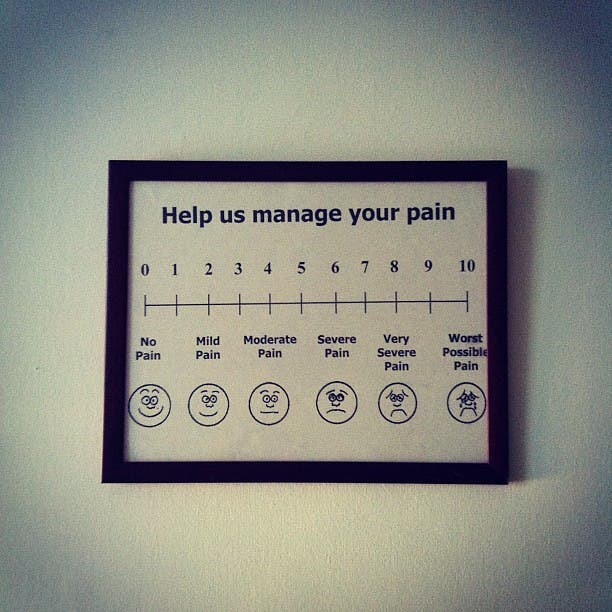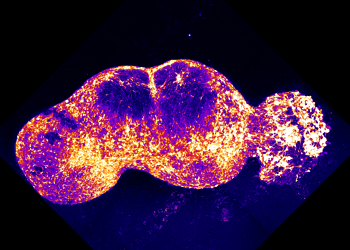Arguably the least enjoyable sensation out of them all, pain always demands attention — and a reaction. But why would biology even give us the ability to feel such a debilitating sensation? Why can’t we just block it out by ourselves? Why even have it in the first place?

Pain is unpleasant by design. It needs to be because it is our body’s alarm system. It warns us whenever some bit isn’t functioning correctly, of issues such as disease or infection, and of damage and injury. But, and this is a very important but, it doesn’t always do that. People can feel phantom limb pain even after having a limb amputated. Injuries can be sustained without any feelings of pain, either temporarily or permanently. Our brain can completely block it out if needed. And things such as loud or high-pitched noises can cause us pain without producing any injury (although they can cause these too).
It also “pains us to say this” sometimes. We all know that it’s a figure of speech, especially in work emails, but is there any literal truth behind that?
First off, what is pain?
From our direct experience of it, it’s easy to start seeing pain as punishment — scratch your knee through carelessness, then it starts hurting to get revenge. In actuality, however, pain is meant as a behavioral corrector. Research in the field showed that it doesn’t have to be produced by tissue damage, but rather works as a preventative as well as a protective mechanism. It is so unpleasant and hard to ignore because it was designed from the ground up to get your attention, hold it, and make you want to make it stop.
We all intimately know that pain is an unpleasant, physical sensation. But its current definition also includes its emotional component, meaning that pain can also be a feeling or a constellation of feelings associated with actual or potential harm.

Physical pain is handled by specialized nerve endings called nociceptors running through and across our bodies. These stay alert for any change that could pose a risk for us, including changes in temperature, chemistry, or pressure. The signals they send to our brains once dangerous thresholds are passed are interpreted or perceived by us as pain. For example, getting bitten hurts because the pressure being applied in that area is almost as great, or greater than, what our skin can safely handle. Keeping your palm on a block of ice for too long starts hurting because it prevents our tissues there from keeping their normal temperature.
Feelings of pain can also be neuropathic in nature (related to damage incurred by the nervous system) or nociplastic (produced by changes in our pain thresholds, generally without injury). The former is the kind of pain you perceive as burning, tingling, or stabbing in your fingers. Diabetes patients often develop long-lasting neuropathic pain, most commonly felt as severe burning pain at night, due to nerve damage incurred by the disease.
It is important to note that like pretty much every other one of our senses, pain doesn’t actually exist, it’s simply a product of our brains. The most concrete manifestation of pain would be the electrical impulses sent out by nociceptors when certain conditions are met. The actual unpleasant sensation you feel, however, is just something your brain creates as it deems necessary. It looks at information such as what threats are present (as informed by our senses), our cognitive state, previous experience with certain types of stimuli, social and cultural norms, and so on.
In other words, when a certain part of you is injured or just not having a good time, it doesn’t hurt; your brain makes you think it hurts. That pain is meant to encourage you to keep said area safe and protected so it can heal. You’ll know how to do so because it will hurt more whenever you don’t. It’s a pretty straightforward system like that.
How we feel it
One thing that I feel is important to note here is that the nerves in our bodies are not made equal.
The nerves in your body are meant to (and are thus specialized to) feel certain kinds of pain in certain ways. For example, the nerves running through your internal organs will readily pick up on distension (stretching), ischemia (reduction in blood flow), or inflammation, beaming these back to you as a diffuse pain. This pain is not highly localized because you don’t really need it to be — all that matters is that you understand there’s something going on inside your belly and you should manage it.
What these visceral nerves are not good at, however, is feeling stuff like cuts or burns. The ones in your skin, meanwhile, are very good at picking up on these, and they’re also very good at pinpointing exactly where the pain comes from. It’s much more important to know where you got a cut on your skin so you can keep it clean and prevent infection, so your body supplies this information.
However, at the end of the day, all nerve fibers make their way to the same spinal cord. But because both areas with a higher sensory density (skin, for example) and those with low sensory density (such as viscera) end up here, their data can get scrambled up. This can produce an effect where pain from one low-sensitivity area can be interpreted as coming from a high-sensitivity area.
Types of pain

The first one we’ll talk about today is ‘referred‘ or ‘reflected’ pain, that’s felt in one part of the body but produced by injuries in another. For example, a kidney stone will make your back hurt, and a stroke can make your jaw sore. Referred pain is produced because the nerve pathways serving the injured areas also connect to others, which may mess up where our brains perceive the pain (although we don’t yet have a good grasp on why it happens). There is also ‘radiating‘ pain, similar to the referred one, with the slight difference that the sensation is also felt in the area that has sustained an injury, not just away from it.
Acute pain is diagnosed mostly based on duration and re-emergence. If the pain can be resolved quickly it is considered to be acute. The exact definitions are still a bit blurry, and the time window used to determine acute pain has varied from 30 days to 6 months, even up to 12 months. One simple way to describe acute pain is that it doesn’t extend beyond the expected period of healing, or that it is short-lived.
On the other hand, we have chronic pain. This can last for years, even your whole lifetime, if you’re particularly unlucky. This can be produced by a variety of conditions, although doctors sometimes make a distinction between cancer-related and benign chronic pain. One easier way of describing it is as pain that extends past the expected period of healing, or that it is long-lasting.
Phantom pain sounds spooky, and it is. This is the type of pain individuals sometimes feel in a limb they lost through accident or amputation. Although a part of their body is gone, these individuals still feel (sometimes very significant) levels of pain in that limb. This is a type of neuropathic pain. It’s a very common symptom, occurring in over 80% of upper-limb amputees and over 50% of lower-limb amputees.
Breakthrough pain is often associated with cancer patients, but they’re not the only ones to experience it. Breakthrough pain is a ‘background’ pain that’s usually controlled by medication but sometimes ‘breaks through’ these in bouts of acute pain.
Finally, to your brain, emotional pain is almost the same as the physical kind; which is why breakups are so enjoyable.
How do pain blockers work?

Pain pathways form a very intricate system in our bodies. This is also by design: our ability to feel pain has to be reliable, because it’s meant to keep us alive.
However, our brains can block out pain when needed. If we find ourselves in a dangerous situation where tending to our wounds is not possible — when we’re facing a predator, for example — pain can become counterproductive. The sensation could limit our range of motion or willingness to move and fight in this scenario. As such, our brains temporarily block painful sensations to allow us to escape or prevail. You’ve probably also experienced getting injured during a tense or dangerous situation and only later noticing it. Adrenaline or states of shock can also block out the sensation of pain.
This process takes place without our input and isn’t reproducible at will. Still, having the ability to stop pain is very handy, so we’ve developed ways of doing so. Anesthetics or pain blockers work by either preventing nerve endings from transmitting pain signals to the brain, or in one way or another stopping the brain from producing a painful sensation.
General anesthesia, for example (the kind you’d get before surgery) disrupts nerve activity throughout your whole body. This prevents us from feeling pain while under anesthesia, and blocks our recollection of it afterwards. All the extra bits that come with general anesthesia — the specialized doctor who administers the drugs and monitors you, tubes to feed oxygen into your lungs, monitoring devices — are all there because anesthesia basically shuts down your nervous system. If not done properly, this can and will kill you, most commonly by breaking the communication lines between your brain, heart, and lungs.
There are four stages to general anesthesia — induction, delirium, surgery anesthesia, and overdose.
- Induction starts when the drugs are administered, and lasts until you fall asleep. During this stage, you’ll still be able to talk and focus to some extent. However, your breathing will slow down, and you’ll slowly lose the ability to feel pain.
- The delirium phase is quite dangerous, and an anesthesiologist will do their best to make it last for as brief a time as possible. This step takes place as the nerves connecting your body to your brain stop working properly, making bits of you act weird. The delirium phase can produce uncontrolled movements, irregular breathing, and can lead to an increase in your heart rate. It’s also possible to see patients vomit during this stage, which can be quite deadly (there is a significant risk of choking).
- In the surgical anesthesia phase, things calm down a little. A patient’s eyes stop moving and their muscles relax completely. It’s very possible that a patient in this state is unable to breathe unassisted. This is the ideal state for surgery and the one an anesthesiologist will try to keep you in as it is the least dangerous stage apart from induction.
- The overdose stage takes place if too much anesthesia is administered to a patient. It’s rarer nowadays, but it’s still a very dangerous event with a high risk of being fatal. The risks are related to the communication lines between your brain, heart, and lungs going completely silent. If a patient is not brought up fast enough, or his breathing and heartbeat not maintained artificially, he will die.
Local anesthesia is far less powerful, affects a much smaller, more controlled area, but it’s also less risky. The most reliable way to differentiate local from general anesthesia is that the former involves loss of pain sensation but not loss of consciousness — general anesthesia leads to a temporary loss of both.
Local anesthetics typically work by blocking certain biochemical pathways inside nerve cells in a certain area. Most commonly, they target sodium ion pumps on the membranes of cells. This effectively prevents those cells from sending signals to the brain, as the electrical signals our bodies rely on are mediated by ions zipping here and there over nerve cells.
Psychological pain

The muddier and arguably worse type of pain, psychological pain can be summarized as ‘suffering’. It’s also referred to as emotional or mental pain, and is usually described as a deeply unpleasant but hard to delineate feeling.
Since people are complex creatures, psychological pain is hard to define in concrete terms. It encompasses a wide range of feelings and subjective experiences produced by the awareness of negative events or changes in one’s life, abilities, bodily functions, social standing, and so forth. Perceived shortcomings or deficiencies in the self can also lead to psychological pain. Losing a loved one is a major cause of psychological pain and, for better or for worse, an inescapable part of being human.
Being a deeply subjective experience, psychological pain is much harder to discuss in concrete terms. One of the most commonly used definitions of psychological pain today is that it is caused by our unmet psychological needs (making it the opposite of happiness). Unlike physical pain, it is most often described as being a diffuse sensation without necessarily having a known cause, is seen as generally long-lasting, and as having an adverse effect on the self and our ability to function.
Art has long grappled with themes of suffering, emotional distress, how these impact us, and it may be, in many ways, one of our most efficient tools in learning how to deal with psychological pain on a personal level. Therapy also works wonders. You can mix and match them if you need to.
To wrap things up
Pain, to hold to the definition we started this journey with, is meant to help correct our poor behavior — i.e. do things that hurt your body then feel pain, so, hopefully, you’ll stop doing the bad thing. Psychological pain, then, can also be seen as a way to correct our poor behavior in the social or cognitive realm.
This gives pain, and especially suffering, a strange double nature. They both are supremely unpleasant to us, but they are also great teachers. People will go to great lengths to avoid pain, which shows just how great this feeling is at correcting behavior. In fact, Freudian psychology considers the ability to endure pain now for a worthy outcome (delayed gratification) as the hallmark of maturity, as we don’t really have free will until we can face the fear of pain and overcome it (the pleasure principle vs reality principle).
People have recognized this nature for millenia now. The oldest stories we know of, such as the Epic of Gilgamesh, the Iliad, or creation myths around the world, delve deeply into experiences such as loss of a loved one and/or rebirth, loss of social standing and power, of being far away from home unable to return. Characters, be they mortals or gods, are shown to pass through suffering and emerge anew on the other side — sometimes stronger, sometimes weaker for it. Others, like Darth Vader for example, try and fail to overcome their suffering, and become defined by it until they succeed. Those are the kinds of stories that still captivate us because we can all understand and have experienced psychological pain, and desire to see our heroes and villains overcome it and get their due.
I’ll end with a quote from Fyodor Dostoevsky, a titan of the Russian novel, that I feel perfectly encapsulates humanity’s unique relationship to pain. Dostoyevsky started his adult life as an idealistic, passionate political reformist. A religious awakening after a mock execution and a real sentence in a Siberian labor camp (he was a very interesting guy) led him to a captivation with how the human ‘soul’ (in his words) or psychology (in modern parlance) works. His writing is very good, if at times disjointed (he was suffering from a particularly debilitating form of epilepsy), so go read them if you like exploring new depths of despair. But until then I leave you with this quote from his 1864 book Notes from the Underground:
“And why are you so firmly, so triumphantly, convinced that only the normal and the positive — in other words, only what is conducive to welfare — is for the advantage of man? Does not man, perhaps, love something besides well-being? Perhaps he is just as fond of suffering? Perhaps suffering is just as great a benefit to him as well-being?”
“Man is sometimes extraordinarily, passionately, in love with suffering, and that is a fact.”






